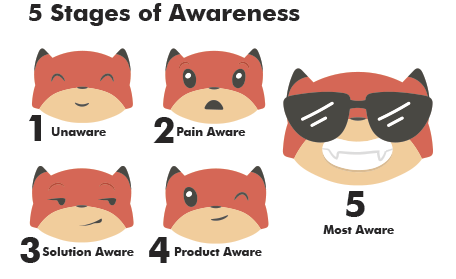
This week, we’re moving up the marketing awareness scale and so we landed in the kingdom of “Problem Aware” prospects. It’s the second stage on our scale. And just for a record, there are five marketing awareness stages and they range between prospect being completely unaware that they even have a problem and a raving fan of the brand that needs no persuasion (example: hardcore fans of Apple).
We’re still more to the right but which means that engaging that audience will be quite a copywriting challenge but the good news is that people at that stage can make for a big audience you can gain lots of new customers from. In general, the closer to the right, the harder crafting your marketing message (copy) is. The more aware your prospects are, the easier it gets.
Putting theory into practice, we’re talking about things like Sales Letters, Video Sales Letters, Facebook, Google, LinkedIn Ads or Even Instagram Ads. At this stage all of these forms would start with the prospect’s problem.
So now that you’ve done a thorough research of your audience, you’ve got a unique chance to truly sympathize and connect with them on a deeper level. Knowing, but more importantly showing that you understand all the ins and outs of their problem will put you ahead of your lazier competitors.
Especially those who didn’t adjust their marketing message to the specific context and try to hammer their offer into prospects’ heads by overly pushy and uncalibrated communication.
So, how to reach that level of intimate connection and write copy so compelling that it will click with readers right out of the gate?
Investigate their pain points.
Find out what keeps them awake at night.
Learn what emotions play the dominant role? Shame? Anger? Guilt? Frustration? Sense of defectiveness? Not feeling loved or understood?
Identifying the unspoken worry and tapping to it is more powerful than bringing up surface-level problems.
Once you delve deeper into your target group’s psyche, establishing a “personal conversation” will be much easier.
Just be careful with lingering on the problem for too long.
Now, you might want to ask how to actually go about digging all of this up and that’s a good question.
If you cannot do your research by simply talking to people in your target audience directly, find out where they hang on the Internet and study what they gripe about. The thing is that people with worries often can’t help talking. Look for patterns and always ask yourself “what is the real pain, the innermost feeling that they’re experiencing?”.
Find out blogs, magazines and podcasts they consume, study other solutions to the same problem or simply your competitors’ products along with their reviews.
Look for threads on Quora/Reddit or comments under YouTube videos where people openly share their issues with others and often get high-quality, substantive answers/advice for their posts.
And finally, when it comes to tying your offer into your marketing message at the end, , paint vivid pictures of how your product will erase your prospect’s fears and frustrations. How it will ease his feelings of guilt, shame or prevent future embarrassment/humiliation. Relieve them from their loneliness, sadness or FOMO (fear of missing out)
Example time. I am yet to find an ecommerce ad that fits the criteria above (and that’s because vast majority of eCommerce ads could definitely use some work) but the IT Education Program by CodeAcademy comes to the rescue here
Stay tuned for the next episode where I’ll be talking about the next stage on the scale which is Solution-aware.
Now, here’s something to consider…
If you have a weird feeling that you’re leaving money on the table because people skip past your emails/ads and you want an extra set of trained, brown and charming eyeballs to look at your stuff—I might be the guy you want to schedule for a free copy-audit. You can book it here: https://calendly.com/oscarolczakcopywriting/30min
Alternatively, you can share this article with someone you think could benefit from reading it or leave a comment below. Because why not.